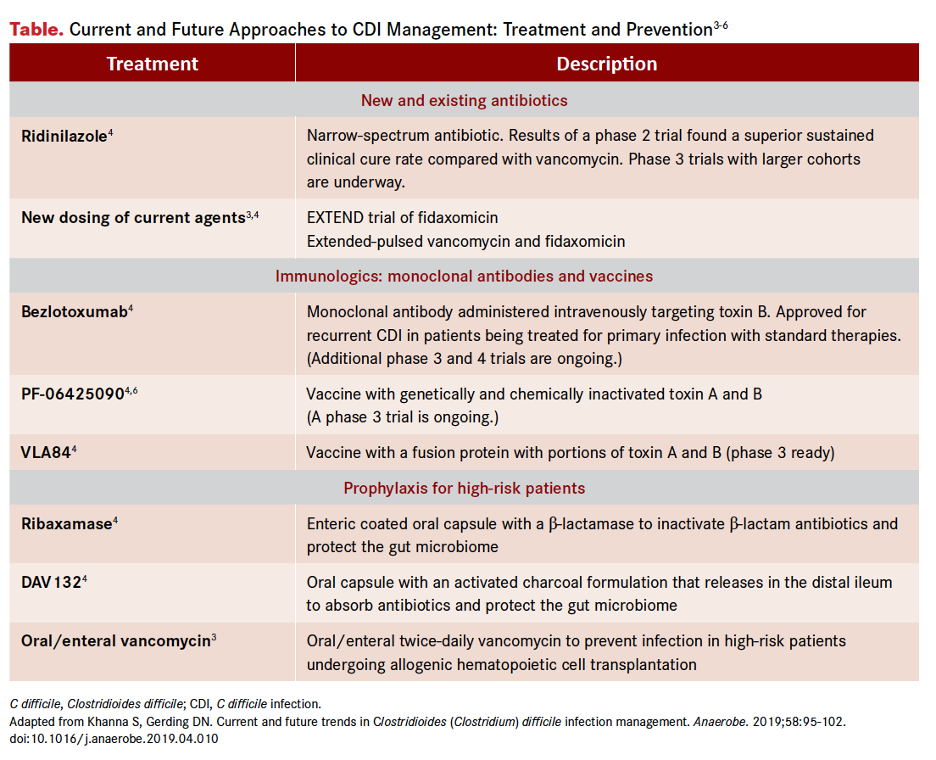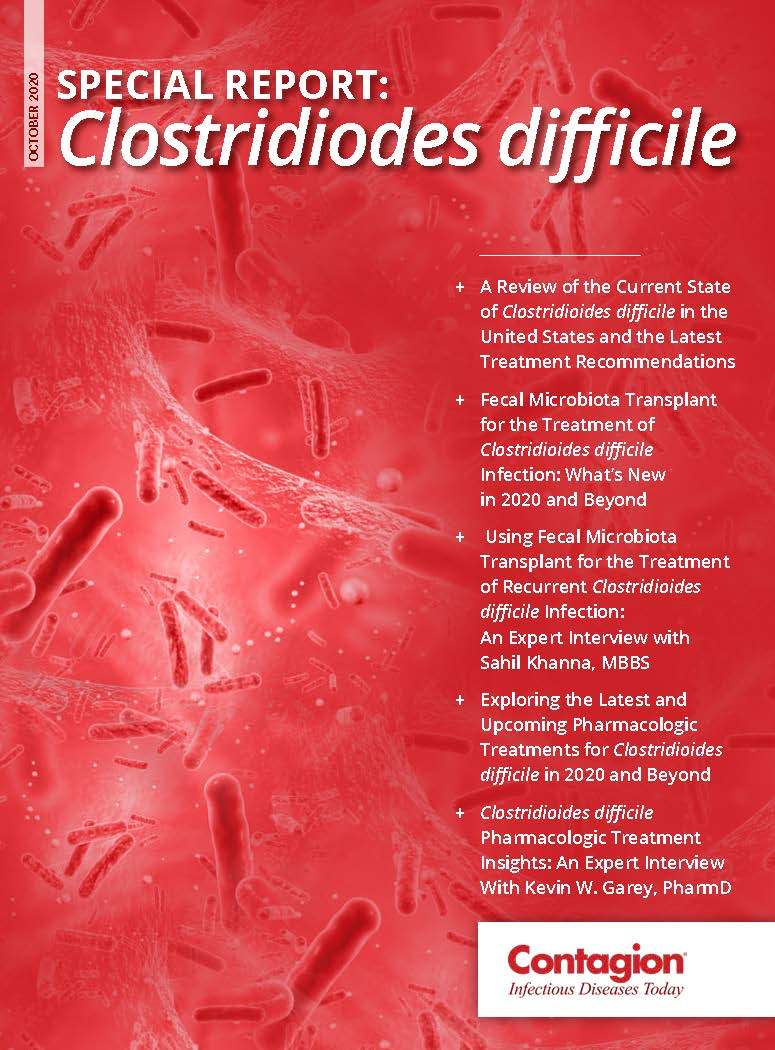Exploring the Latest and Upcoming Pharmacologic Treatments for Clostridioides difficile in 2020 and Beyond
The outbreaks of Clostridioides difficile infection (CDI) over the past 2 decades1 and the high annual economic burden of approximately $6.3 billion associated with infections2 highlight the need for additional treatment options.3 The landscape for treatment of CDI is rapidly changing. Examples of current and upcoming therapies are detailed in the Table.3-6
Antibiotics
Antibiotics have long been the gold standard of treatment for initial and recurrent CDI. Vancomycin and metronidazole were the first 2 widely used treatments.4 Vancomycin is a glycopeptide, while metronidazole is a nitroimidazole derivative.7 Although both have shown efficacy against C difficile, vancomycin has become established as a preferred option due to its minimal absorption and lower risk of adverse effects compared with metronidazole.8 Recent study results also suggest that vancomycin may have a lower failure rate and improved clinical success, and guidelines of organizations like the Infectious Diseases Society of America (IDSA) and the Society of Healthcare Epidemiology of America (SHEA) recommend it as a first-line option.8-10
The macrocyclic antibiotic fidaxomicin is also recommended as a first-line option.8 The therapy has minimal systemic absorption and is highly selective for C difficile, leading to a favorable safety profile.3,8 Both vancomycin and fidaxomicin are actively being explored in trials examining alternative dosing to more effectively treat recurrent CDI.3 Several retrospective observational trials suggest that taper-and-pulse dosing of these regimens could be effective treatment options.3,4,8
Several trials have also explored the use of novel antibiotics, like surotomycin and cadazolid, although some firms have discontinued development of their agents after they did not show efficacy comparable with that of existing therapies.3 On the other hand, the narrow-spectrum antibiotic ridinilazole has shown cure rates superior to those of vancomycin.3 Furthermore, fewer patients on ridinilazole showed recurrent infection compared with those on vancomycin. Ridinilazole’s apparent efficacy and safety could make it a potential future therapy for management of CDI.3
Immunologics
Another treatment option category being explored for CDI includes the use of passive or active immunity to target the toxins of the pathogen.4 For example, the monoclonal antibody bezlotoxumab targets toxin B of C difficile to prevent the toxin from binding to host cells. The therapy is approved as an adjunct to standard antibiotic treatment to prevent recurrent CDI.3,4
Injectable antitoxin vaccines are an additional immunologic option; 2 with potential are in later- stage clinical trials. The vaccine candidate PF-06425090 (in phase 3 trials)6 contains inactivated toxin A and B, whereas the candidate VLA84 is ready for a phase 3 trial and consists of a single recombinant fusion protein with both toxins. Both have so far demonstrated a good immune response and safety profile.4
Prophylaxis for High-Risk Patients
One approach to preventing CDI is to treat high-risk patients prophylactically. For example, patients who are taking antibiotics for purposes besides treatment of CDI, and particularly those who are undergoing autologous and allogenic hematopoietic cell transplantation (HCT) and taking antibiotics, may be at high risk for dysbiosis of the gut microbiome and, subsequently, CDI.4,8,11 The oral capsule DAV132 is formulated with activated charcoal to allow release in the distal ileum and enable antibiotic neutralization. The therapy was shown to able to largely preserve the fecal microbiota of patients taking oral moxifloxacin and had a favorable safety profile.4 One effective prophylactic approach could be neutralizing the effect of antibiotic treatments on patients’ microbiota. These types of therapies must selectively neutralize the antibiotic in the lower gastrointestinal tract to prevent colonization, but not interfere with antibiotic absorption.4
CDI can be life-threatening for patients undergoing autologous and allogenic HCT.12 One developmental therapy utilizing a neutralization approach is the oral β-lactamase ribaxamase or SYN- 004. The therapy has an enteric coat to protect it from disintegration in the gut, and it then releases in the lower gastrointestinal tract when the pH rises.4 The therapy successfully targeted ceftriaxone in a proof-of-concept trial,4 and a phase 1b/2a trial is planned in patients undergoing allogenic HCT who are being treated with intravenous β-lactam antibiotics to examine prevention of dysbiosis of the gut microbiome.11 As an alternative prophylactic approach to antibiotic neutralization, a study presented at the 2020 Transplantation and Cellular Therapy Meetings of the American Society for Transplantation and Cellular Therapy and the Center for International Blood and Marrow Transplant Research explored the use of oral/enteral twice-daily 125-mg vancomycin as a prophylaxis in allogeneic transplant recipients. The treatment resulted in a significant drop in CDI and there were no reported adverse events or positive vancomycin-resistant enterococcus screens or infections, suggesting this could be a safe and effective strategy to reduce CDI.12

Reemphasizing the Importance of Antibiotic Stewardship
Recently, researchers identified a new strain of C difficile—ribotype 591—in a US acute care hospital; it is related to virulent ribotype 027, which has been responsible for outbreaks throughout this country and world.5,13 The new strain appears highly resistant to clindamycin, but continued monitoring and research is needed to understand if the strain causes the same disease severity or spreads as readily as ribotype 027.5 Notably, the strain has also been found in 3 tertiary hospitals in Colombia.5
The development of additional virulent and antibiotic-resistant strains of C difficile highlights the need for improved antibiotic stewardship. The number of prescribed antibiotics, the length of antibiotic exposure, and antibiotic dose all correlate with infection risk. Responsible use of antibiotics by reducing the frequency and duration of their use, and minimizing their prescription, can go a long way toward limiting C difficile outbreaks.8 Furthermore, because different strains can have a range of patterns of antibiotic resistance, prescribed antibiotics used to target CDI can also be based on local epidemiology and strain information. However, fluoroquinolones, clindamycin, carbapenems, and cephalosporins should generally be included in antibiotic stewardship programs, given that these antibiotics are shown to contribute to a higher risk of CDI.8
Conclusions
The treatment landscape for CDI is changing to possibly include emerging antibiotics, immunologics (monoclonal antibodies and vaccines), and prophylactic options for high-risk patients. Unfortunately, virulent and antibiotic resistant strains of C difficile remain a problem, emphasizing the importance of effective antibiotic stewardship programs.
References
1. Guh AY, Kutty PK. Clostridioides difficile infection. Ann Intern Med. 2018;169(7):ITC49-ITC64. doi:10.7326/AITC201810020
2. Zhang S, Palazuelos-Munoz S, Balsells EM, et al. Cost of hospital management of Clostridium difficile infection in United States—a meta-analysis and modelling study. BMC Infect Dis. 2016;16(1):447. doi:10.1186/s12879-016-1786-6
3. Mendo-Lopez R, Villafuerte-Gálvez J, White N, et al. Recent developments in the management of recurrent Clostridioides difficile infection. Anaerobe. 2020;62:102108. doi:10.1016/j.anaerobe.2019.102108
4. Khanna S, Gerding DN. Current and future trends in clostridioides (clostridium) difficile infection management. Anaerobe. 2019;58:95-102. doi:10.1016/j.anaerobe.2019.04.010
5. Skinner AM, Petrella L, Siddiqui F, et al. Unique clindamycin-resistant Clostridioides difficile strain related to fluoroquinolone-resistant epidemic BI/RT027 strain. Emerg Infect Dis. 2020;26(2):247-254. doi:10.3201/eid2602.181965
6. Taylor P. Chasing Sanofi, Pfizer tees up phase 3 trials for C. diff vaccine. Fierce Biotech. January 27, 2017. Accessed September 30, 2020. https://www.fiercebiotech.com/biotech/chasing-sanofi-pfizer-tees-up-phase-3-trials-for-c-diff-vaccine
7. Antibiotic resistance threats in the United States, 2019. CDC. 2019. Revised December 2019. Accessed September 30, 2020. https://www.cdc.gov/drugresistance/pdf/threats-report/2019-ar-threats-report-508.pdf
8. McDonald LC, Gerding DN, Johnson S, et al. Clinical practice guidelines for Clostridium difficile infection in adults and children: 2017 update by the Infectious Diseases Society of America (IDSA) and Society for Healthcare Epidemiology of America (SHEA). Clin Infect Dis. 2018;66(7):e1-e48. doi:10.1093/cid/cix1085
9. Zar FA, Bakkanagari SR, Moorthi KMLST, Davis MB. A comparison of vancomycin and metronidazole for the treatment of Clostridium difficile—associated diarrhea, stratified by disease severity. Clin Infect Dis. 2007;45(3):302-307. doi:10.1086/519265
10. Johnson S, Louie TJ, Gerding DN, et al; Polymer Alternative for CDI Treatment (PACT) Investigators. Vancomycin, metronidazole, or tolevamer for Clostridium difficile infection: results from two multinational, randomized, controlled trials. Clin Infect Dis. 2014;59(3):345-354. doi:10.1093/cid/ciu313
11. Synthetic biologics receives FDA guidance at type C meeting for SYN-004 (ribaxamase) phase 1b/2a clinical trial in allogeneic HCT recipients. News release. Synthetic Biologics; January 7, 2020. Accessed September 30, 2020. https://www.prnewswire.com/news-releases/synthetic-biologics-receives-fda-guidance-at-type-c-meeting-for-syn-004-ribaxamase-phase-1b2a-clinical-trial-in-allogeneic-hct-recipients-300982096.html
12. Matheny C, Rattani N, Garcia-Frausto E, et al. Enteral vancomycin is effective: Clostridium difficile prophylaxis in pediatric, adolescent, and young adult hematopoietic stem cell transplant recipients. Biol Blood Marrow Transplant. 2020;26(suppl 3):S143. doi:10.1016/j.bbmt.2019.12.672
13. Clements AC, Magalhães RJ, Tatem AJ, et al. Clostridium difficile PCR ribotype 027: assessing the risks of further worldwide spread. Lancet Infect Dis. 2010;10(6):395-404. doi:10.1016/S1473-3099(10)70080-3

